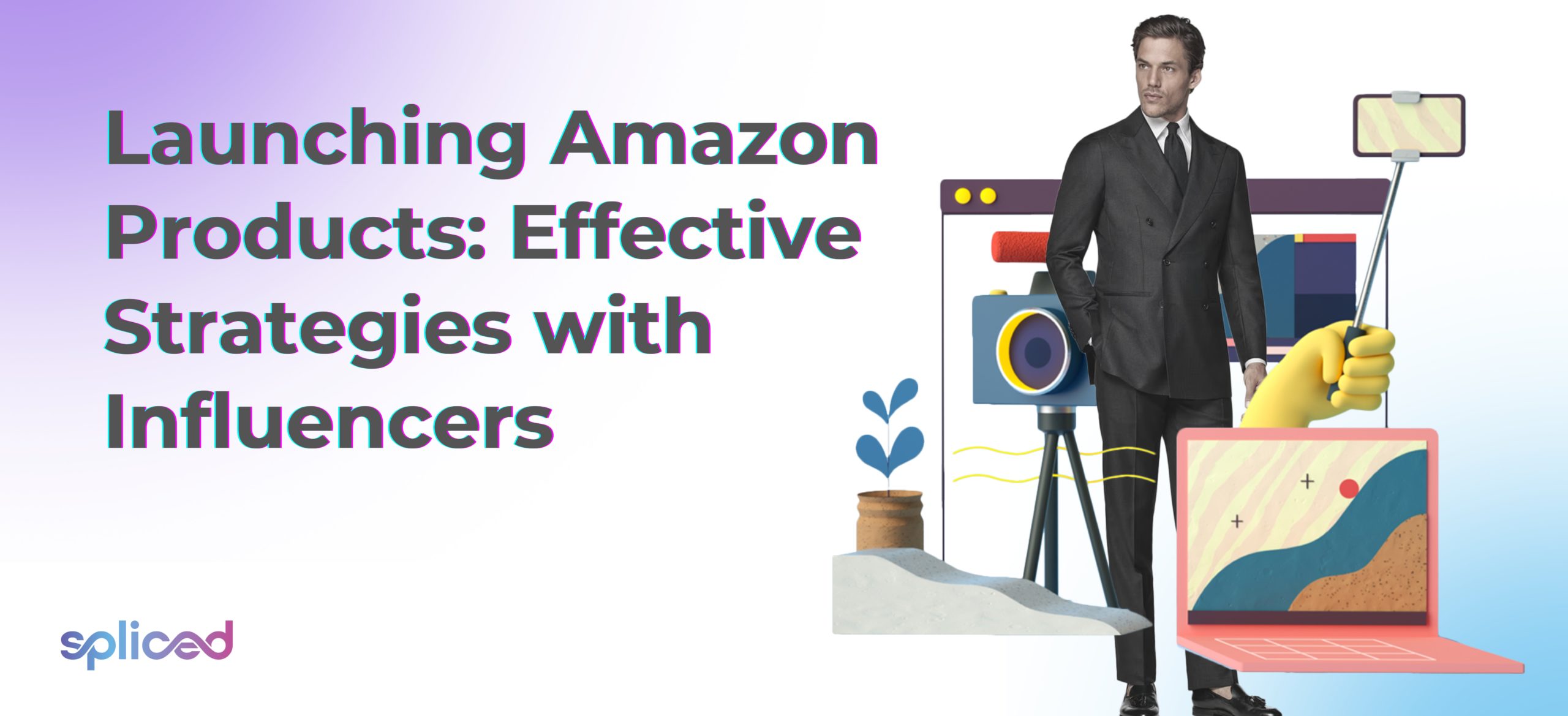Launching a product on Amazon is a challenging endeavor, but one effective method that has gained prominence is leveraging influencers to boost visibility and drive sales. A well-structured approach is crucial to successfully launching a product on Amazon using influencers. Here’s a comprehensive overview of the key steps to launch a new product on Amazon effectively.
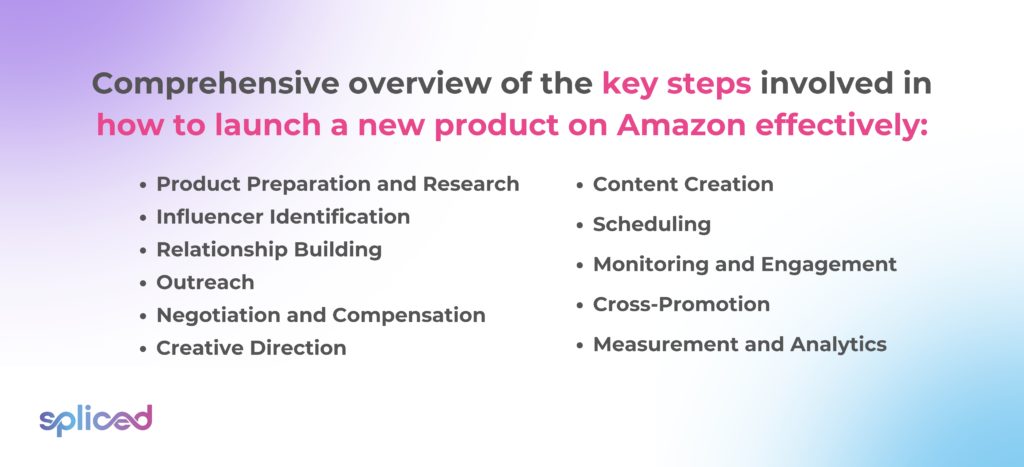
- Product Preparation and Research: Thorough preparation and research are essential. Ensure the product is market-ready and has a unique selling proposition (USP) that sets it apart in the crowded Amazon marketplace.
- Influencer Identification: Identifying the right influencers that are compatible with the product and target audience is a key element in launching a product on Amazon.
- Relationship Building: Building relationships with influencers is about establishing trust and mutual understanding. Engage with them genuinely on social media platforms and understand their interests and values.
- Outreach: Reach out to them professionally after identifying potential influencers. Explain the product and the potential collaboration benefits clearly to successfully launch a product on Amazon.
- Negotiation and Compensation: Negotiate terms of collaboration, which include compensation, product samples, or affiliate commissions. Ensure that both parties are satisfied with the arrangement.
- Creative Direction: Provide influencers with a clear creative direction, but allow them creative freedom to ensure authenticity.
- Content Creation: Influencers create content that showcases the product, contributing to how to successfully launch a product on Amazon. The content must resonate with their followers and highlight the product’s benefits.
- Scheduling: Plan the content release schedule to maximize its impact, a crucial aspect of launching a product on Amazon. Consider the best times for the target audience and coordinate with influencers accordingly.
- Monitoring and Engagement: Keep a close eye on the campaign’s progress. Engage with the influencer’s audience by responding to comments and questions promptly.
- Cross-Promotion: Encourage influencers to cross-promote on their other social media channels or platforms, amplifying the product’s reach during the Amazon product launch.
- Measurement and Analytics: Use tools and analytics to track the campaign’s performance. Monitor metrics such as traffic, conversions, and ROI to assess the campaign’s effectiveness when launching a product on Amazon.
- Long-Term Relationships: Building long-term relationships with influencers is beneficial for future product launches. Nurturing the connections leads to ongoing collaborations and brand loyalty, ensuring successful product launches on Amazon.”
Incorporating influencers into the Amazon product launch strategy significantly heightens visibility and drives sales. Follow the steps and enhance the approach to effectively harness the impact of influencers on how to launch products on Amazon and achieve the company’s targets.

1. Product Preparation and Research
Product preparation and research to sell on Amazon is exactly the process of analyzing what’s selling in the marketplace to secure a profitable position. The basic concept is to look for cheap products and sell them on Amazon for a profit.
Begin with comprehensive market research. The research entails delving into various categories and niches to identify trends and pinpoint products in high demand. Conduct a thorough competitor analysis within the chosen niche. Examine their product listings, pricing strategies, customer reviews, and any unique selling points they employ. It’s crucial to assess profitability by calculating potential profit margins. Consider sourcing costs, Amazon fees, shipping expenses, and other related costs in the evaluation. Utilizing tools such as Amazon’s FBA calculator is invaluable. Develop a clear sourcing strategy by determining how and where to procure the products, which involves finding suppliers, manufacturers, or wholesalers offering competitive prices. Perform comprehensive keyword research to identify the most relevant and high-traffic keywords associated with the chosen products. The research plays a vital role in optimizing the product listings for better visibility and sales performance on Amazon.
The importance of doing the necessary research before starting an Amazon business is critical. The fundamental steps are pivotal to success for several reasons. They serve to minimize risk by being able to carefully select products with a higher likelihood of success, thus reducing the chance of investing in items that have fewer buyers. Effective research allows the individual to identify products with favorable profit margins, ensuring a substantial return on their investment. Research provides a competitive edge by helping to understand the competitors and giving the person insights to differentiate the offerings through pricing, unique features, or innovative marketing strategies. It facilitates keyword optimization, enhancing the product’s visibility in Amazon’s search results, a critical factor for driving sales. A well-researched product strategy lays a solid foundation for a sustainable Amazon business, significantly increasing the prospects for long-term success in the competitive marketplace.
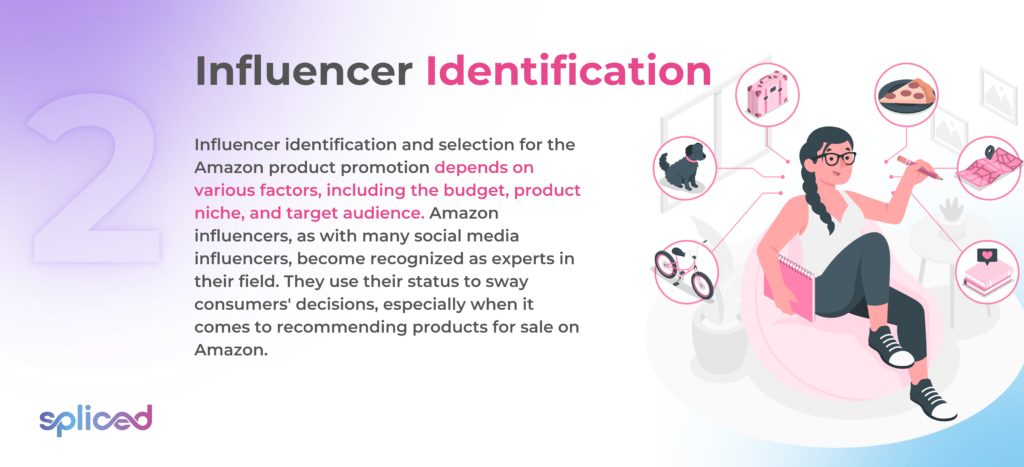
2. Influencer Identification
Influencer identification and selection for the Amazon product promotion depends on various factors, including the budget, product niche, and target audience. Amazon influencers, as with many social media influencers, become recognized as experts in their field. They use their status to sway consumers’ decisions, especially when it comes to recommending products for sale on Amazon.
Finding the best people to promote Amazon products requires a thorough evaluation process. Start by closely examining the influencer’s posts and the content they share. Evaluating whether their style and communication align harmoniously with the brand’s image and values. Delve into how the influencer interacts with their audience, particularly within the comments section of their posts. Gauge the authenticity, positivity, and respectfulness of the interactions. Examine the quality of the influencer’s followers by scrolling through their follower list. Determine whether the followers are genuinely engaged and exhibit a sincere interest in the influencer’s content. Asking important questions such as “How often do you promote products?” “How engaged are you with your followers?” “How authentic is their audience?” and “How interested are they in your brand?” help to make a well-informed choice. Selecting influencers who effectively represent the brand and connect with the target audience requires a rigorous evaluation process.
There are several important benefits that highlight the effectiveness of prioritizing authenticity and relevance when looking for Amazon influencers. Paying more attention to the details than to the number of followers helps the product promotion reach an audience that is genuinely interested. Authentic influencers inherently possess credibility and the trust of their audience, lending more weight and credibility to product endorsements and potentially resulting in higher conversion rates. Authentic influencers consistently produce content that aligns with the brand and product, making their endorsements feel genuine and non-promotional. The approach mitigates the risk of associating the brand with influencers who have artificially inflated follower counts. The emphasis on authenticity and relevance tends to yield a more favorable return on investment (ROI) by effectively engaging and influencing an engaged audience, enhancing the effectiveness of Amazon marketing efforts.
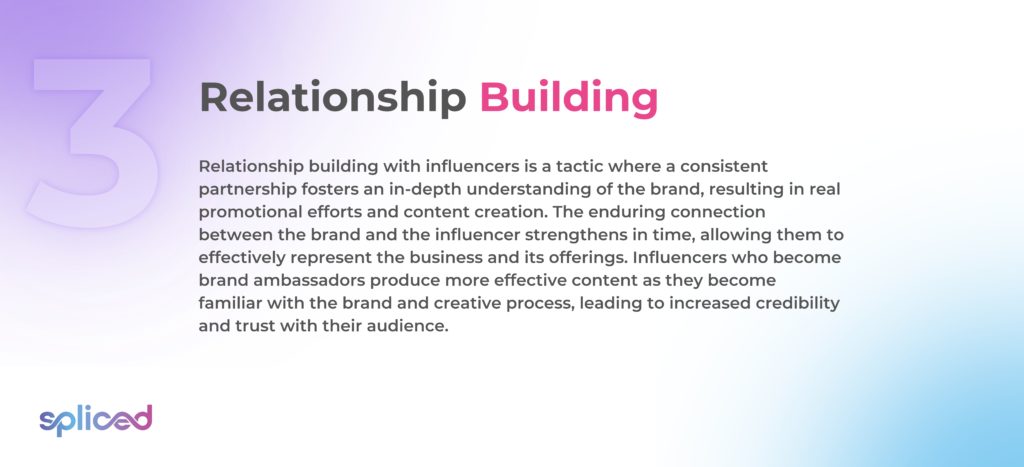
3. Relationship Building
Relationship building with influencers is a tactic where a consistent partnership fosters an in-depth understanding of the brand, resulting in real promotional efforts and content creation. The enduring connection between the brand and the influencer strengthens in time, allowing them to effectively represent the business and its offerings. Influencers who become brand ambassadors produce more effective content as they become familiar with the brand and creative process, leading to increased credibility and trust with their audience.
Establish a dependable pattern of collaboration by maintaining a consistent schedule, ensuring a sustained and meaningful partnership. Prioritize open and transparent communication with influencers. Keep them well-informed about the brand’s values, objectives, and upcoming campaigns, promoting a mutual understanding of shared goals. Create a feedback loop, encouraging influencers to provide insights and opinions about their experience collaborating with the brand and endorsing the products. The feedback is invaluable for refining future collaborations and making them more effective. Build relationships with influencers based on mutual respect and appreciation. Recognize and value their creative contributions and expertise, establishing a foundation of trust. Offer influencers opportunities for creative expression within the boundaries of the brand’s guidelines. Extend value beyond monetary compensation by offering exclusive access or early product launches to enhance their partnership experience. Invest in a lasting partnership to turn influencers into loyal brand promoters. Their commitment solidifies their connection to the business, resulting in more impactful and enduring influencer relationships.
Cultivating enduring relationships with influencers yields a multitude of benefits that significantly enhance the effectiveness of the influencer marketing strategy. The more familiar influencers become with the company and its products, the more likely they are to produce marketing content that accurately reflects the brand. Brand ambassadors are those who work with a company in a long-term partnership. They understand the brand’s essence, creative processes, and audience expectations and use the knowledge to great effect when promoting the brand through content that resonates with their audience. Consistently working with influencers increases the likelihood of converting their audience into customers because it establishes credibility and trust with their followers and with the brand. Influencers who share the values and mission are able to convey both the product benefits and the commitment to social good, creating a comprehensive and positive reputation. Long-term partnerships prove cost-efficient as the time and effort required for influencer onboarding decrease with each subsequent campaign, further optimizing the marketing strategy.
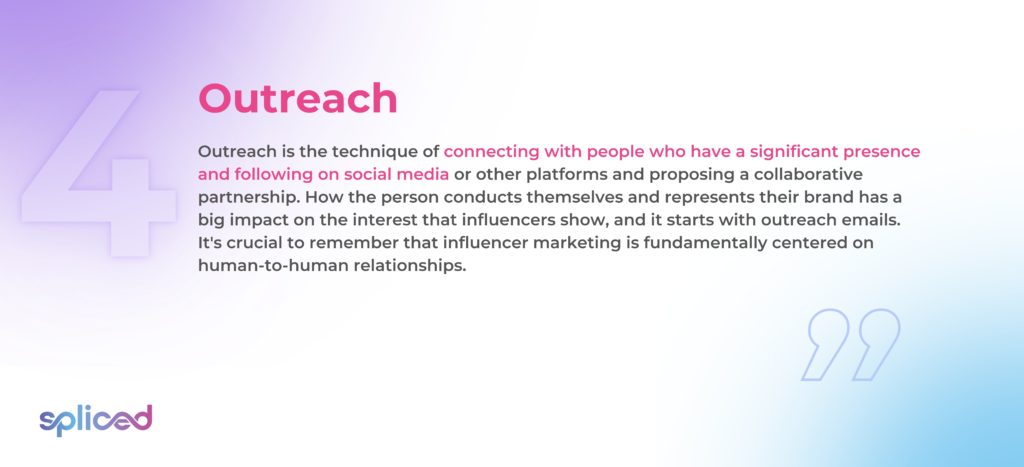
4. Outreach
Outreach is the technique of connecting with people who have a significant presence and following on social media or other platforms and proposing a collaborative partnership. How the person conducts themselves and represents their brand has a big impact on the interest that influencers show, and it starts with outreach emails. It’s crucial to remember that influencer marketing is fundamentally centered on human-to-human relationships.
Begin by selecting the most suitable communication channel, whether it’s direct messaging (DMs) on social platforms or email, based on the influencer’s preferences. Keep the initial contact concise and clear, introducing oneself and providing a brief background on the brand. Present the brand with a direct yet compelling introduction. Highlight the brand’s mission, values, and unique qualities that set it apart in the market. The key to capturing an influencer’s interest lies in personalization. Clearly articulate why they’ve chosen them for potential collaboration. Refer to specific aspects of their content, expertise, or audience alignment that resonate with the brand’s objectives. The likelihood of a positive response is increased due to the personalized approach, which shows that the person has done their research and added relevance to the outreach.
The effectiveness of outreach to influencers is a critical factor in the success of influencer marketing campaigns. Effectiveness is rooted in several key principles. Initiating contact with influencers in a respectful and personal manner establishes a meaningful human connection, emphasizing the inherently human aspect of influencer marketing. A well-crafted outreach message that introduces the brand and conveys genuine interest has a higher chance of capturing the influencer’s attention and curiosity. Explaining why they were chosen as influencers for the brand based on their content, expertise, or audience alignment demonstrates diligence and adds relevance to the outreach. Effective outreach sets the stage for building positive and enduring relationships with influencers, creating a foundation for productive and authentic collaborations. Understanding an influencer’s work and values helps them show interest in the brand and the possibility of collaboration, which improves the success of the influencer marketing campaign as a whole.
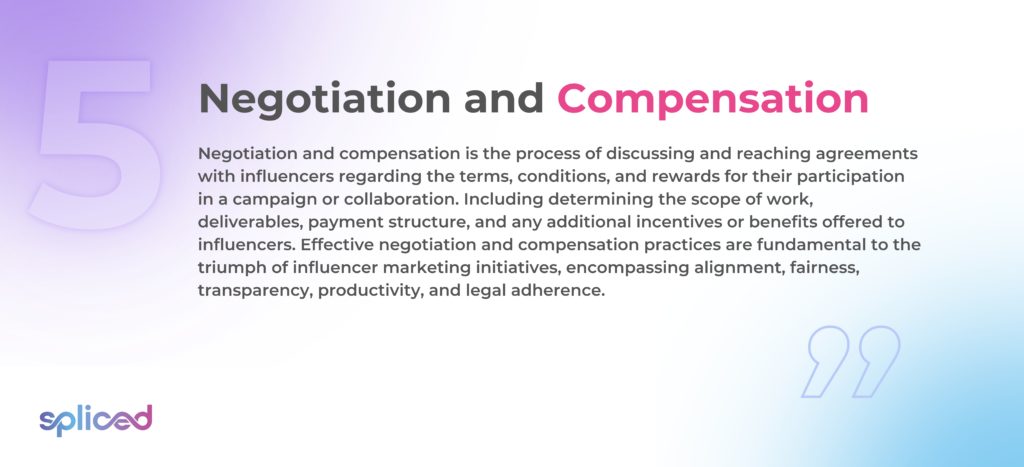
5. Negotiation and Compensation
Negotiation and compensation is the process of discussing and reaching agreements with influencers regarding the terms, conditions, and rewards for their participation in a campaign or collaboration. Including determining the scope of work, deliverables, payment structure, and any additional incentives or benefits offered to influencers. Effective negotiation and compensation practices are fundamental to the triumph of influencer marketing initiatives, encompassing alignment, fairness, transparency, productivity, and legal adherence.
Effective negotiation and compensation in influencer marketing entail a structured approach that ensures a mutually beneficial partnership. It begins by clearly defining campaign objectives and goals, providing a solid understanding of the desired outcomes from the influencer collaboration. Assessing the influencer’s value, including their reach, engagement, and alignment with the brand, helps determine their contribution to the campaign’s success.
The compensation structure, which involves payment, product offerings, affiliate commissions, or a combination thereof, must be carefully established to align with the budget and meet the influencer’s expectations. Defining the scope of work, such as content types, quantity, posting schedules, and specific creative requirements, sets the groundwork for a productive collaboration.
Outlining the terms and conditions of the partnership, encompassing aspects such as content ownership, usage rights, disclosure requirements, and deadlines, is vital for clarity and legal compliance. Maintaining open channels for negotiation, considering the influencer’s input and preferences, to enhance the partnership’s effectiveness. Documenting all agreements in a written contract or agreement offers clarity and provides legal protection for both parties involved. The systematic approach ensures that influencer collaborations are well-structured, transparent, and conducive to achieving the desired campaign goals.
Effective negotiation and compensation are integral components of a successful influencer marketing campaign, underpinning various facets of its effectiveness. They foster alignment between all parties involved, ensuring a shared understanding of campaign objectives, deliverables, and expectations. The alignment serves as a solid foundation for productive collaboration.
Offering fair and competitive compensation to influencers serves as a potent motivator, encouraging them to deliver high-quality content while nurturing a positive and mutually beneficial working relationship. Transparency in negotiations plays a critical role, as it builds trust and reduces the likelihood of misunderstandings or disputes throughout the campaign’s lifecycle.
Effective negotiation streamlines campaign planning, execution, and monitoring processes, enhancing productivity. Efficiency contributes significantly to achieving campaign goals. Effective negotiations result in clear and well-defined terms and conditions that help ensure compliance with applicable laws and regulations, such as disclosure requirements for sponsored content.
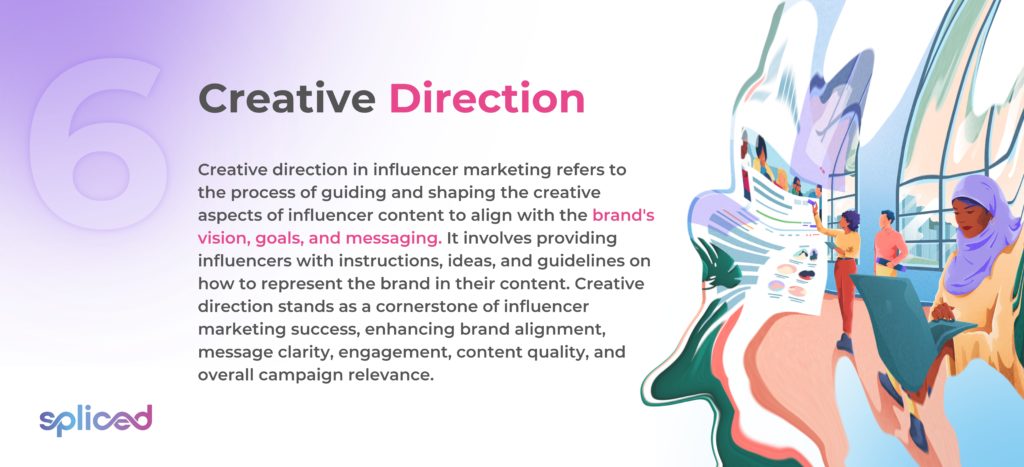
6. Creative Direction
Creative direction in influencer marketing refers to the process of guiding and shaping the creative aspects of influencer content to align with the brand’s vision, goals, and messaging. It involves providing influencers with instructions, ideas, and guidelines on how to represent the brand in their content. Creative direction stands as a cornerstone of influencer marketing success, enhancing brand alignment, message clarity, engagement, content quality, and overall campaign relevance.
Effective creative direction within influencer marketing relies on a structured approach encompassing several key steps. Establish clear campaign objectives that align with the brand’s broader strategy, ensuring a cohesive message. Understanding the influencer’s content style, audience, and creative strengths is equally vital, as it allows for tailored creative direction that capitalizes on their unique capabilities.
Detailed guidelines must be provided to influencers, covering content format, tone, and key messaging. Specific product features or benefits that require emphasis must be highlighted. Active collaboration with the influencer is encouraged, fostering open communication and an exchange of creative ideas. The collaborative approach leads to the creation of more authentic and engaging content.
A feedback loop must be established, involving regular reviews of influencer drafts and the provision of constructive feedback. The iterative process ensures alignment with brand objectives and maintains content quality standards. Respecting the influencer’s creative freedom and allowing them to incorporate their individual style and personality into the content results in a more authentic and compelling message.
Creative direction wields significant influence over the effectiveness of influencer marketing campaigns, contributing to various critical aspects. Creative direction upholds brand consistency, ensuring that influencer-generated content seamlessly aligns with the brand’s messaging and upholds a uniform image. Strengthening brand recognition and cultivating trust among the audience.
Creative direction is important for conveying campaign messages with the utmost clarity. Creative direction acts as a guiding force that ensures the intended audience receives information accurately and comprehensively, minimizing the risk of misinterpretation. Well-directed content tends to be inherently more engaging, fostering resonance with the influencer’s audience and, subsequently, higher levels of interaction and trust.
The collaborative nature of effective creative direction, which is characterized by regular feedback and constructive collaboration, results in the creation of high-quality content. Reflecting positively on the brand and product, reinforcing a favorable image.
The precision of tailored creative direction ensures that the influencer’s content remains consistently relevant to the campaign objectives. Relevance maximizes the content’s impact on the target audience, increasing its efficacy in achieving campaign goals.

7. Content Creation
Content creation refers to the process of generating the visual, written, or multimedia materials that influencers use to engage and influence their audience on behalf of a brand. Content creation covers the creation of promotional content, product showcases, and other materials that align with the brand’s marketing goals. Content creators and influencers have distinct but complementary roles within the process.
Effective content creation within the realm of influencer marketing is a methodical process that involves several crucial steps. It commences with the establishment of clear campaign objectives, defining the type of content required to fulfill the objectives. It is equally important to comprehend the influencer campaign’s target audience to create content that deeply resonates with them.
Collaboration with influencers stands as a pivotal phase, demanding close coordination to harmonize content creation with their distinctive style, voice, and audience. The collaboration must be built on authenticity, ensuring that the content maintains the influencer’s genuine character. The subsequent phase revolves around the creation of high-quality assets, encompassing visually captivating visuals, well-crafted copy, or multimedia elements. The elements must consistently align with the brand’s identity.
Maintaining uniformity in messaging, branding, and quality throughout the influencer campaign is essential to sustaining the efficacy of content creation. Content must be adapted to suit the platform or platforms where it is disseminated, optimizing it to conform to each channel’s unique requirements. Compliance with advertising regulations, encompassing proper disclosure for sponsored content, is imperative to avoid legal complications and preserve transparency with the audience. Effective content creation embodies a systematic approach that ensures alignment with campaign objectives, audience resonance, influencer collaboration, quality consistency, platform adaptability, and regulatory adherence, all contributing to the triumph of influencer marketing initiatives.
Successful influencer marketing initiatives rely heavily on high-quality content generation, which provides many advantages. Content creation is a powerful driver of audience engagement. Expertly designed content has the power to attract an influencer’s audience, leading to greater levels of engagement and more interactions.
Content creation serves as a vehicle for precise brand representation. High-quality content accurately mirrors the brand’s identity and values, thereby fortifying brand recognition and trust among the audience. It acts as a conduit for the efficient delivery of campaign messages, ensuring that the messages are effectively conveyed to the target audience and enhancing the chances of message retention.
Collaborative content creation allows influencers to maintain their authenticity while advocating for the brand, rendering the content more relatable and persuasive. Tailoring content to the specific platform where it is shared maximizes its efficacy, as it better resonates with the platform’s user base and aligns with prevailing trends.
Ensuring regulatory compliance in content creation is paramount. Adhering to advertising regulations and disclosure requirements prevents legal complications and fosters transparency with the audience, bolstering trust and credibility. Effective content creation acts as a cornerstone in influencer marketing, contributing to audience engagement, brand representation, message delivery, influencer authenticity, platform suitability, and regulatory adherence, all of which collectively drive the success of influencer campaigns.
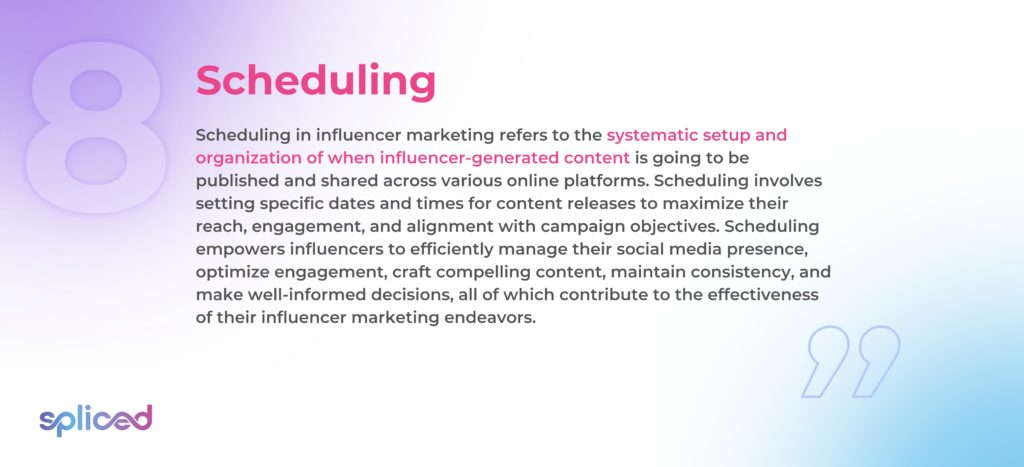
8. Scheduling
Scheduling in influencer marketing refers to the systematic setup and organization of when influencer-generated content is going to be published and shared across various online platforms. Scheduling involves setting specific dates and times for content releases to maximize their reach, engagement, and alignment with campaign objectives. Scheduling empowers influencers to efficiently manage their social media presence, optimize engagement, craft compelling content, maintain consistency, and make well-informed decisions, all of which contribute to the effectiveness of their influencer marketing endeavors.
Utilizing scheduling tools and techniques offers numerous advantages to influencers for effective management of their social media presence. One key benefit is engagement management, as influencers navigate busy schedules across multiple social media accounts. Scheduling tools empower them to plan and organize their social media activities in advance, ensuring consistent engagement with their audience.
Another crucial aspect that scheduling facilitates is content planning. Influencers invest time and creativity in crafting content that resonates with their followers. Scheduling allows influencers to meticulously plan and prepare their content, ensuring that each post delivers substantial value and effectively engages their audience.
Maintaining a 24/7 online presence becomes achievable through scheduling. Given that followers span different time zones, influencers are unable to provide instant responses to comments and messages. Influencers maintain an uninterrupted online presence, even during their periods of unavailability with scheduling, thereby reaching a broader and more diverse audience.
Scheduling saves valuable time for influencers and enhances efficiency. Automating the scheduling of posts frees up influencers to focus on producing engaging material and developing meaningful connections with their audiences.
Consistency is paramount in building and retaining audience trust and interest. Scheduled posts ensure that influencers adhere to a regular posting schedule, reinforcing their brand identity and meeting audience expectations consistently.
Scheduling tools that frequently offer robust metrics and analytics facilitate performance tracking. Influencers closely monitor the performance of their content, tracking engagement levels, reach, and other crucial indicators. The data-driven approach allows influencers to make informed decisions and refine their content strategies for better results.
Scheduling supports ethical compliance on social media platforms. Each platform has specific ethical guidelines that influencers must adhere to. Scheduling allows influencers to effectively manage their content in alignment with the guidelines, swiftly addressing any potential ethical issues in a strategic and timely manner.
Scheduling within influencer marketing brings about a range of advantageous outcomes for influencers. Scheduling enhances the efficiency of their audience engagement efforts, allowing for a more consistent presence and the cultivation of stronger connections with their followers. It empowers influencers to allocate more time and energy towards producing high-quality content, ensuring that each post delivers genuine value to their audience.
Scheduled posts have the potential to reach a wider and more diverse audience, accommodating varying time zones and individual schedules. That has a multiplier effect on the influencers’ overall influence and reach. A consistent posting schedule helps influencers establish credibility with their followers, and the time savings afforded by scheduling allow them to devote their attention instead to strategic endeavors and the development of fresh, engaging content.
Another perk is that many scheduling tools provide helpful performance metrics, allowing for data-driven decision making. The metrics allow influencers to gauge the effectiveness of their content and make informed adjustments to their strategies for improved outcomes.
Scheduling aids influencers in maintaining ethical standards on social media platforms. It assists them in adhering to ethical guidelines and effectively addressing any ethical issues that arise. Scheduling elevates the efficiency and effectiveness of influencer marketing for influencers, allowing them to engage their audience, craft compelling content, expand their reach, save time, build trust, make data-driven decisions, and manage ethical considerations more adeptly.
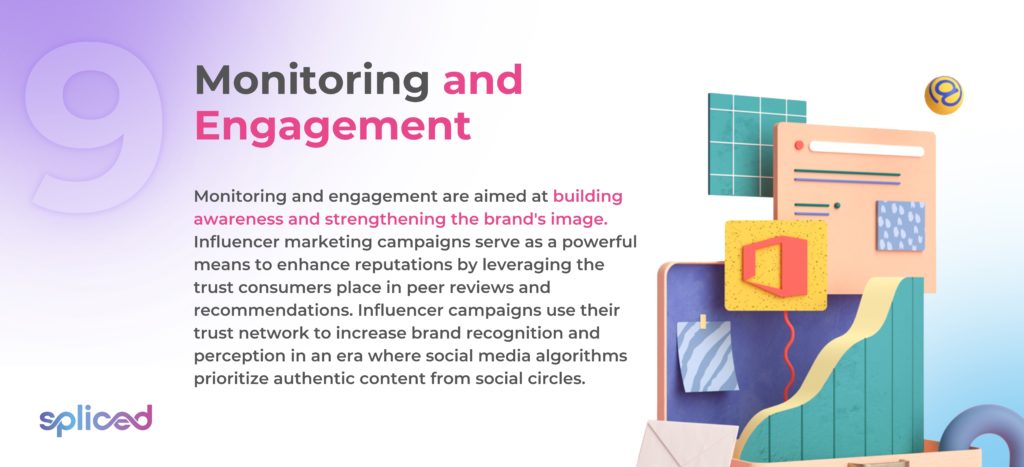
9. Monitoring and Engagement
Monitoring and engagement are aimed at building awareness and strengthening the brand’s image. Influencer marketing campaigns serve as a powerful means to enhance reputations by leveraging the trust consumers place in peer reviews and recommendations. Influencer campaigns use their trust network to increase brand recognition and perception in an era where social media algorithms prioritize authentic content from social circles.
Influencer marketing is a dynamic and impactful strategy that revolves around partnering with individuals who wield significant influence, particularly those with a substantial and engaged following on various social media platforms. Influencers serve as invaluable partners in the promotion of products, services, or the overarching brand itself. The fundamental strength of the marketing approach lies in the deep and authentic connections influencers have cultivated with their dedicated fan bases.
Influencers aren’t merely social media celebrities. They are trusted figures who have earned the loyalty and admiration of their followers. The influencer’s ability to resonate with their audience extends beyond mere popularity. It is rooted in the authenticity and relatability they bring to their content. It’s not just an advertisement when an influencer backs a product or supports a brand. It’s a genuine recommendation from someone who has earned the trust of their audience.
Influencers have painstakingly built their personal brands by consistently delivering content that aligns with their interests, values, and expertise. The alignment creates a strong bond between the influencer and their followers, resulting in a unique form of trust. Their fans see them as more than just content creators. They see them as peers, role models, or friends whose opinions and recommendations hold tremendous weight.
Familiarity and trust are put to good use when influencers partner with companies to introduce their audiences to new offerings. The recommendations sound closer to actual advice from a reliable source than typical advertising. That means that when the influencer makes a recommendation, their devoted audience is inclined to pay attention, engage, and even take some sort of action.
Influencer marketing is a form of online advertising that capitalizes on consumers’ need for recommendations from people they know and trust. It acknowledges that even in a world flooded with advertisements, individuals place a premium on the thoughts of those they trust and are connected to. The influencers’ communities benefit from the consistent delivery of high-quality material, while the brands’ visibility and trustworthiness increase.
Monitoring and engagement are effective components of influencer marketing in achieving the primary objectives of building brand awareness and enhancing the brand’s image. Their effectiveness is rooted in several crucial factors. Influencer marketing leverages the trust and credibility influencers have painstakingly built with their dedicated followers. The influencers are more than mere content creators. They’re trusted figures whose opinions hold considerable weight. Their content is inherently authentic and relatable, creating a stronger connection with audiences than traditional branded content. Their genuineness is very appealing to customers and helps boost the company’s reputation.
Influencer marketing capitalizes on the remarkable reach influencers possess, allowing brands to tap into vast and engaged audiences that are difficult to access. Influencers essentially serve as trusted peers, with their recommendations carrying the weight of peer influence, which is known to be highly persuasive among consumers. Social media algorithms prioritize authentic content from users’ networks, further enhancing the visibility and engagement of influencer-generated content. Monitoring and engagement practices contribute to building enduring relationships between brands, influencers, and their respective audiences. Maintaining brand recognition and encouraging a favorable impression of the brand over time relies heavily on the strength of relationships.

10. Cross-Promotion
Cross-promoting is a powerful marketing strategy that helps small businesses and influencers reach new audiences, boost their credibility, and increase their sales. Campaigns showcasing each other’s products or services to each other’s followers are created through partnerships with other businesses or influencers who share a common target market, values, and goals.
Cross-promotion has the potential to be an effective marketing strategy if it is carried out correctly. Select partners whose niche, audience, and style align with the product but aren’t direct competitors. Look for partners with strong reputations, loyal followings, and high engagement levels, ensuring a mutually beneficial collaboration.
Open clear lines of communication with partners to establish campaign objectives and expectations. Define the goal to achieve, how success is measured, and each partner’s contributions. Including specifics such as the number of posts, content type, messaging, timeline, and budget. Agree on tracking methods, such as unique hashtags, links, or coupon codes.
Craft content that adds value to the partners’ audiences, avoiding overly promotional approaches. Focus on providing useful information, tips, reviews, or testimonials that highlight the offerings’ benefits and features. Ensure that the content aligns with the partners’ brand voice, tone, and style.
Actively promote the cross-promotion campaign by sharing content across various channels, from the website to social media platforms and email lists. Encourage followers to explore the partners’ content as well. Engage with the partners’ audiences by interacting with their feedback, inquiries, or suggestions. Express gratitude and aim to build trust and rapport with each other and their followers.
Cross-promotion is a highly effective strategy for both small businesses and influencers alike. The approach facilitates the expansion of reach, enhances credibility, and has the potential to boost sales tremendously. Collaborating with partners who align with the target market’s values and objectives allows one to create campaigns that showcase their offerings to each other’s followers. It broadens the audience and nurtures trust and engagement within the partner’s established community. Cross-promotion is beneficial for both parties when conducted in an honest and transparent manner, helping both businesses expand their customer bases and raise their brands’ public profiles.
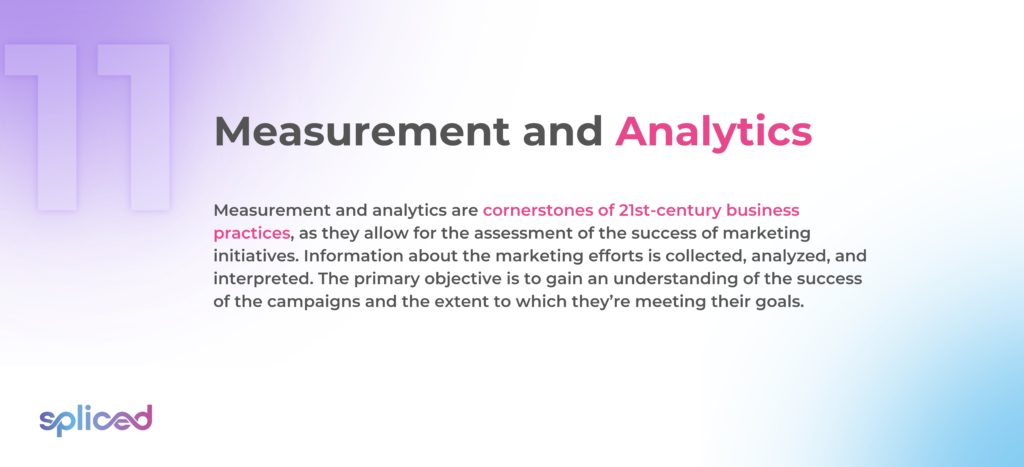
11. Measurement and Analytics
Measurement and analytics are cornerstones of 21st-century business practices, as they allow for the assessment of the success of marketing initiatives. Information about the marketing efforts is collected, analyzed, and interpreted. The primary objective is to gain an understanding of the success of the campaigns and the extent to which they’re meeting their goals.
Measuring campaign success encompasses a broad spectrum of metrics and key performance indicators (KPIs) that provide invaluable insights into marketing efforts. The critical aspects include monitoring brand awareness, evaluating customer engagement through metrics such as likes and comments, measuring conversion rates, assessing the effectiveness of online advertising through clickthrough rates (CTR), calculating the cost per lead (CPL) to gauge lead generation efficiency, identifying marketing-qualified leads (MQLs) and sales-qualified leads (SQLs) to understand prospects’ readiness to convert, and determining the ultimate measure of success, return on investment (ROI). The metrics collectively form the foundation for evaluating, optimizing, and aligning marketing strategies with specific business objectives, ultimately contributing to growth and success.
Effectiveness in measurement and analytics lies in selecting the right metrics that align with specific business objectives and continuously monitoring and analyzing the data to make informed decisions. It is an iterative procedure that helps improve their marketing tactics, spend money wisely, and ultimately expand the business.
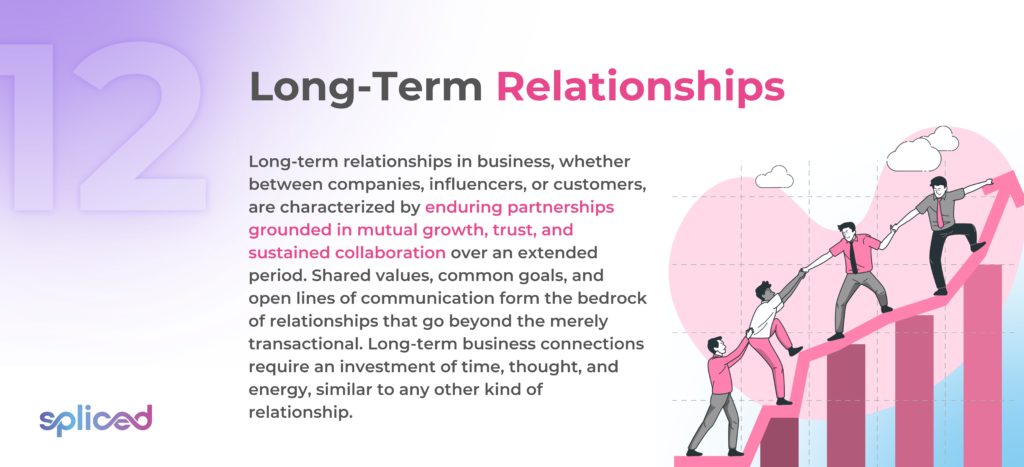
12. Long-Term Relationships
Long-term relationships in business, whether between companies, influencers, or customers, are characterized by enduring partnerships grounded in mutual growth, trust, and sustained collaboration over an extended period. Shared values, common goals, and open lines of communication form the bedrock of relationships that go beyond the merely transactional. Long-term business connections require an investment of time, thought, and energy, similar to any other kind of relationship. The success of the company depends on its dedication to its tasks. Invest time and effort into developing the bonds, and show them how much they’re valued by expressing gratitude and respect for them.
Building enduring, long-term relationships in business is a strategic endeavor that hinges on several fundamental principles. Trust is the foundation on which all other relationships are built, so it is of the utmost priority. Building trusting connections requires prioritizing truthfulness, dependability, and openness. Open lines of communication and attentive listening are two more cornerstones for success in any endeavor. A shared set of values and objectives provides a common purpose, strengthening the partnership’s foundation. Revenue, growth, exposure, or other benefits must accrue to both parties for the relationship to be successful. Flexibility and adaptability are essential as business landscapes evolve, as do the needs and expectations of partners and customers. Consistency in delivering quality reinforces trust, and expressing appreciation and recognition for contributions further solidifies bonds. Addressing conflicts constructively instead of avoiding them is vital for resolving issues and preserving long-term partnerships.
Long-term relationships in the business world are highly effective, offering a multitude of advantages that contribute to sustained success. Enduring partnerships bring stability and predictability, providing a solid foundation for consistent growth. Leading to cost savings, as nurturing existing relationships is more economical than continually acquiring new ones. Long-term partners or customers are more inclined to provide referrals and recommendations, expanding the network and customer base.
Growing relationships with one another over time allows for better tailoring of solutions and enhanced teamwork. Fostering brand loyalty means creating stakeholders who are less susceptible to competitive offers. Long-term partnerships frequently open doors to new opportunities, including joint ventures, co-branding initiatives, and cross-promotion, which further fuel growth and prosperity. A history of successful long-term relationships enhances the company’s reputation and credibility within the industry or niche, solidifying its position as a trusted and respected entity.
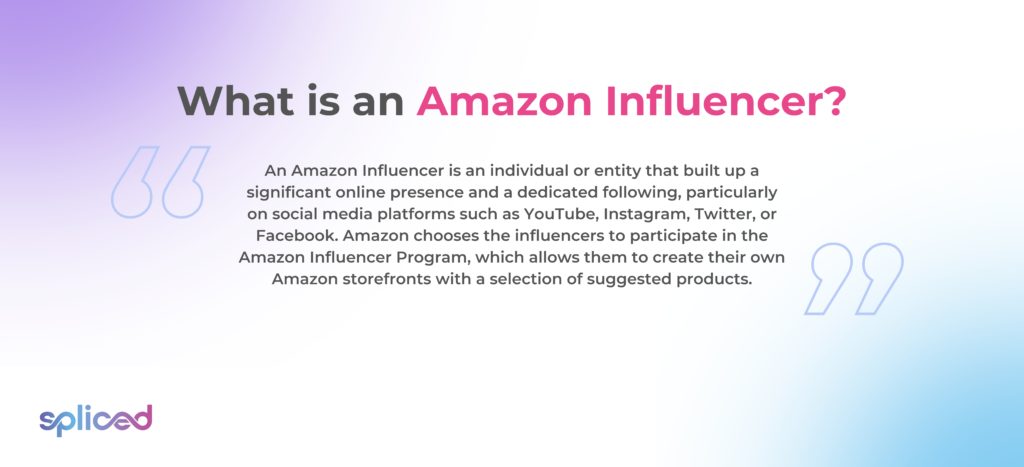
What is an Amazon Influencer?
An Amazon Influencer is an individual or entity that built up a significant online presence and a dedicated following, particularly on social media platforms such as YouTube, Instagram, Twitter, or Facebook. Amazon chooses the influencers to participate in the Amazon Influencer Program, which allows them to create their own Amazon storefronts with a selection of suggested products. The curated lists are shared with their followers, who browse and shop for the featured products directly on Amazon.
Amazon Influencers leverage their credibility and expertise in specific niches or industries to provide product recommendations and reviews. They create content, such as videos, posts, or tweets, showcasing the products they endorse and sharing personal experiences and insights about the items. Their carefully designed stores attract customers and send them to Amazon, where they’re more likely to make a purchase.
Amazon Influencers act as intermediaries between Amazon and their followers, bridging the gap between social media content and e-commerce. Earning commissions on qualifying sales generated through their storefronts, creating a symbiotic relationship where influencers monetize their influence and Amazon benefits from increased product visibility and sales.
The growing body of evidence supports the hypothesis that Amazon Influencers play a critical function in digital marketing by introducing consumers to products they haven’t come across before. Amazon recognizes the value of the influencers and provides them with the means to monetize their influence, ultimately creating a win-win situation for both the influencers and the e-commerce giant.
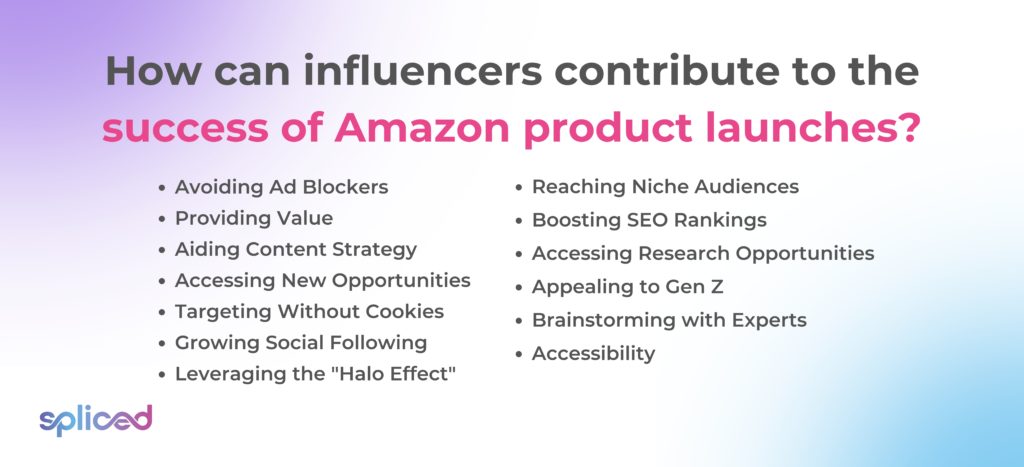
How can influencers contribute to the success of Amazon product launches?
Influencers can contribute to the success of Amazon product launches through the factors listed below.
- Avoiding Ad Blockers: Influencer marketing content bypasses ad blockers, ensuring that the product launch messages reach the intended audience effectively.
- Providing Value: Influencers create content that provides value to the target audience, making the product more appealing and relevant.
- Aiding Content Strategy: Collaborating with influencers complements the content strategy by incorporating their unique perspectives and creative approaches.
- Accessing New Opportunities: Partnering with creators opens up new opportunities, such as creator licensing, extending the reach and impact of the product launch.
- Targeting Without Cookies: Influencers enable precise audience targeting without relying on cookies, ensuring that marketing efforts remain effective in a changing digital landscape.
- Growing Social Following: Creator partnerships help grow social media followings by leveraging their engaged audience base.
- Leveraging the “Halo Effect”: Influencers bring a positive perception and association with the products, contributing to the “halo effect” that enhances the brand’s image.
- Reaching Niche Audiences: Collaborating with niche-specific influencers allows to reach highly targeted audiences interested in Amazon products.
- Boosting SEO Rankings: Influencer marketing improves search engine rankings as influencer-generated content and backlinks contribute to online visibility.
- Accessing Research Opportunities: Partnering with influencers provides valuable insights and research opportunities by tapping into their audience’s preferences and behaviors.
- Appealing to Gen Z: Gen Z is an influential generation, and several influencers have large fan bases among the age group.
- Brainstorming with Experts: Collaborating with creators allows one to brainstorm with experts in the industry, leading to innovative and effective product launch strategies.
- Accessibility: Influencer marketing is accessible to businesses of all sizes, making it a versatile and cost-effective strategy for Amazon product launches.
Influencers benefit from Amazon by earning commissions, having access to Amazon products, boosting their credibility, diversifying, having access to valuable data, and collaborating with Amazon itself. They’re able to monetize their influence by earning commissions or fees through Amazon’s affiliate marketing programs, creating an additional income stream to supplement their earnings. The collaboration provides influencers with access to Amazon’s extensive catalog of products. Access enriches the diversity and quality of content they’re able to generate for their audience, enhancing their content offerings. Influencers build trust among their followers by recommending Amazon products that align with their niche or expertise. The alignment bolsters their credibility and trustworthiness in the eyes of their audience.
Diversification is another advantage, as partnering with Amazon diversifies an influencer’s revenue sources beyond brand partnerships and sponsorships. The reduced dependency on a single income stream enhances their financial stability. Amazon offers influencers access to valuable data and analytics related to their affiliate links. The data empowers them to fine-tune their content strategy and optimize their promotional efforts effectively. Collaboration with a global e-commerce giant such as Amazon opens doors to networking opportunities, potential partnerships, and sponsorships within the industry, further expanding an influencer’s horizons and prospects.
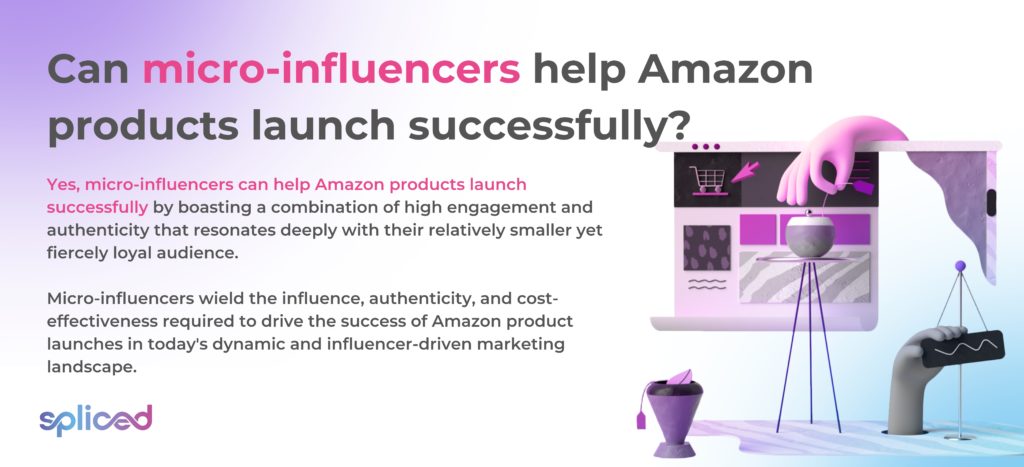
Can micro-influencers help Amazon products launch successfully?
Yes, micro-influencers can help Amazon products launch successfully by boasting a combination of high engagement and authenticity that resonates deeply with their relatively smaller yet fiercely loyal audience. Micro-influencers wield the influence, authenticity, and cost-effectiveness required to drive the success of Amazon product launches in today’s dynamic and influencer-driven marketing landscape. 82% of consumers stated that they’re more inclined to follow a micro-influencer recommendation than more prominent influencers. Followers of micro-influencers place a substantial amount of trust in their recommendations, viewing them as authentic and relatable figures. Trust drives product endorsements, which influence Amazon product purchases.
Micro-influencers possess niche expertise, specializing in specific industries or areas of interest. Promoting Amazon products within their respective niches allows influencers to reach an engaged and attentive audience. A targeted approach greatly boosts the chances of successful conversion and customer acquisition.
Micro-influencers offer a more budget-friendly alternative compared to collaborating with macro-influencers or celebrities. Amazon harnesses the collective power of a network of micro-influencers, orchestrating widespread, cost-effective marketing campaigns for its product launches. The cost-efficiency is particularly advantageous for maximizing the reach and impact of product launches while optimizing marketing expenditure.
Another compelling aspect of micro-influencers is their innate ability to replicate the effects of word-of-mouth marketing. Rely on sharing authentic, first-hand experiences with Amazon products, effectively simulating word-of-mouth recommendations within their follower base. The simulated word-of-mouth approach carries a heightened level of persuasiveness, fostering trust and confidence among their audience.
Micro-influencers possess localized or regional influence, making them invaluable assets for region-specific Amazon product launches. Collaborating with relevant micro-influencers allows Amazon to accurately reach and engage with local or regional audiences, ensuring the message reaches its intended demographic effectively.
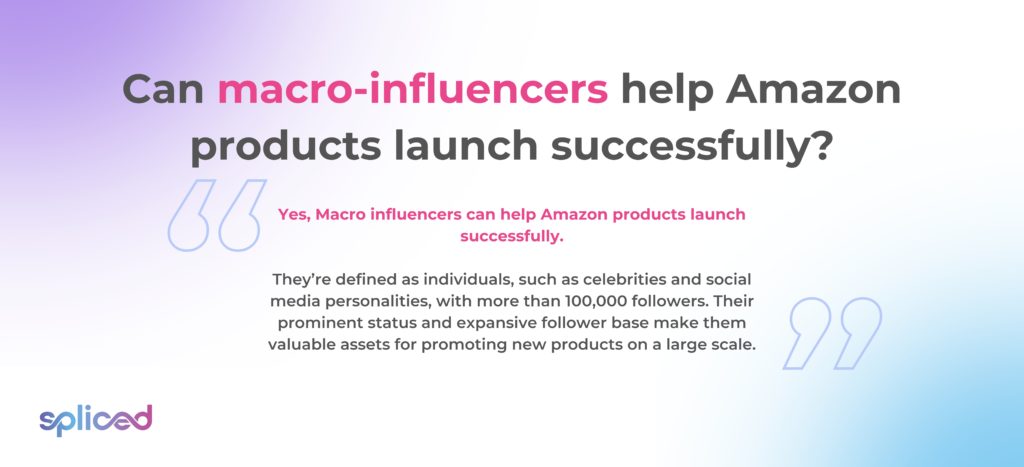
Can macro-influencers help Amazon products launch successfully?
Yes, macro-influencers can help Amazon products launch successfully. They’re defined as individuals, such as celebrities and social media personalities, with more than 100,000 followers. Their prominent status and expansive follower base make them valuable assets for promoting new products on a large scale.
Their immense reach and instant visibility capabilities allow them to swiftly introduce Amazon products to a vast and diverse audience, creating a buzz around the launch that results in increased sales and heightened interest. Partnering with macro-influencers grants Amazon access to their well-established credibility and trustworthiness. The influencers are seen as authorities in their respective niches, making their product endorsements highly persuasive to their extensive follower base. Working with macro influencers is a time-saving strategy compared to coordinating with numerous micro-influencers. Managing a single influencer requires fewer resources and streamlines the campaign process.
Macro-influencers hold the potential to generate substantial media value for Amazon. A single post from a macro influencer is capable of reaching millions of people, greatly enhancing brand exposure and recognition. Their accessibility through various influencer marketplaces and platforms further simplifies the process of finding and collaborating with them. It is important to figure out if these kinds of partnerships are worth the money since macro-influencers cost a lot. Amazon’s brand standards and the core principles of the product being launched must be carefully considered for the campaign to be a success. Evaluate the cost-effectiveness of partnering with macro influencers, as their services come with a significant price tag. A successful campaign requires a macro influencer who is in sync with Amazon’s brand standards and the nature of the product being introduced.
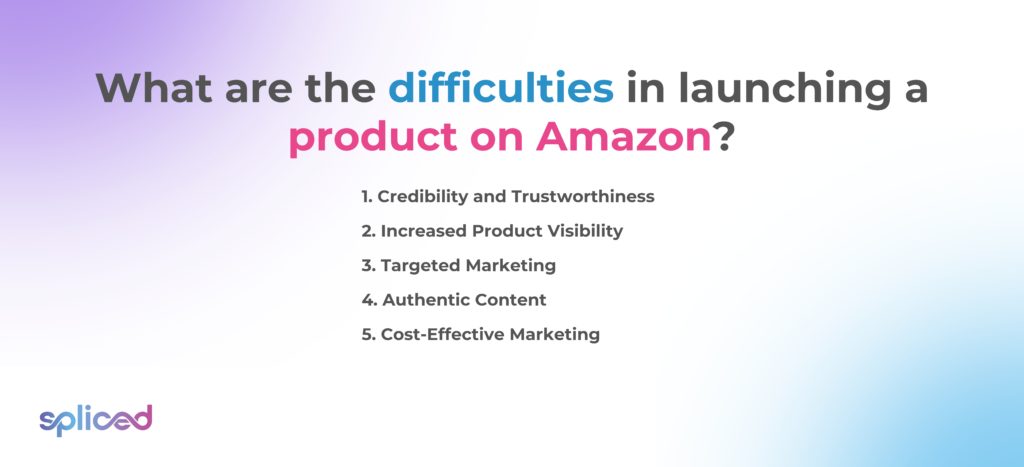
What are the difficulties in launching a product on Amazon?
The difficulties in launching a product on Amazon are listed below.
- Keyword Difficulty: One of the foremost challenges is the intricate landscape of keywords. Amazon’s search engine relies heavily on specific keywords, and selecting the right ones is challenging. The problem is that there are so many products on the platform, all of which are competing for attention. Meticulous keyword research and optimization are essential to overcome it. Businesses must use keyword research tools and monitor their performance regularly to adapt to changing search trends.
- Heavy Competition: Amazon boasts millions of sellers across various niches, resulting in fierce competition. New entrants find it challenging to differentiate their products and establish a presence. Businesses must focus on creating a unique value proposition to address. Offering a product with distinct features, better pricing, or exceptional customer service. Building a brand presence and leveraging social proof, such as customer reviews and ratings, helps distinguish the product in a crowded marketplace.
- Constant Changes: Amazon’s dynamic ecosystem continually evolves, from changes in algorithms to policy updates and platform features. The ever-shifting landscape poses a considerable challenge to sellers, who must stay updated and adapt their strategies accordingly. Remaining informed about Amazon’s policies and staying agile in response to algorithmic changes is crucial. Businesses must keep a close eye on industry trends and competitor actions to maintain a competitive edge.
- Customer Reviews and the Flywheel Effect: Accumulating customer reviews is critical for building trust and credibility on Amazon. The Flywheel Effect, as Amazon calls it, is a positive cycle where sales, customer reviews, and search rankings reinforce each other. Obtaining initial reviews is challenging for new products. Sellers must employ strategies such as providing exceptional customer service to address it, offering high-quality products, and actively seeking reviews from satisfied customers.
- Amazon PPC Campaigns: Pay-Per-Click advertising on Amazon is a valuable tool for boosting product visibility. Optimizing PPC campaigns is complex and requires ongoing management. Overcoming the challenge entails thorough research into relevant keywords, strategic budget allocation, and continuous monitoring and adjustment of ad campaigns to maximize click-through rates (CTR) and conversion rates.
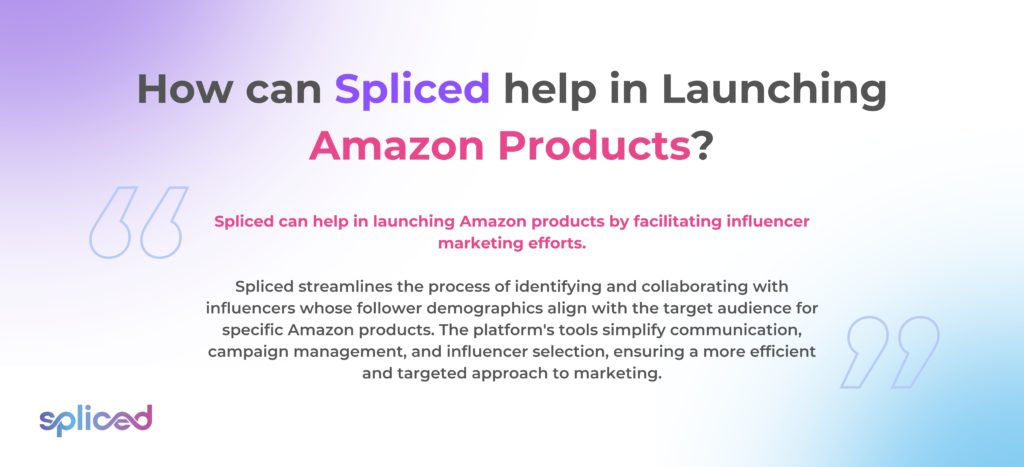
How can Spliced help in Launching Amazon Products?
Spliced can help in launching Amazon products by facilitating influencer marketing efforts, Semantic SEO based on the latest COSMO and Rufus advanced AI systems as well as product promotions and giveaways. Spliced streamlines the process of identifying and collaborating with influencers whose follower demographics align with the target audience for specific Amazon products. The platform’s tools simplify communication, campaign management, and influencer selection, ensuring a more efficient and targeted approach to marketing. Spliced includes analytics features to monitor campaign effectiveness and calculate ROI, making it a valuable asset for businesses aiming to promote their products on Amazon through influencer partnerships.
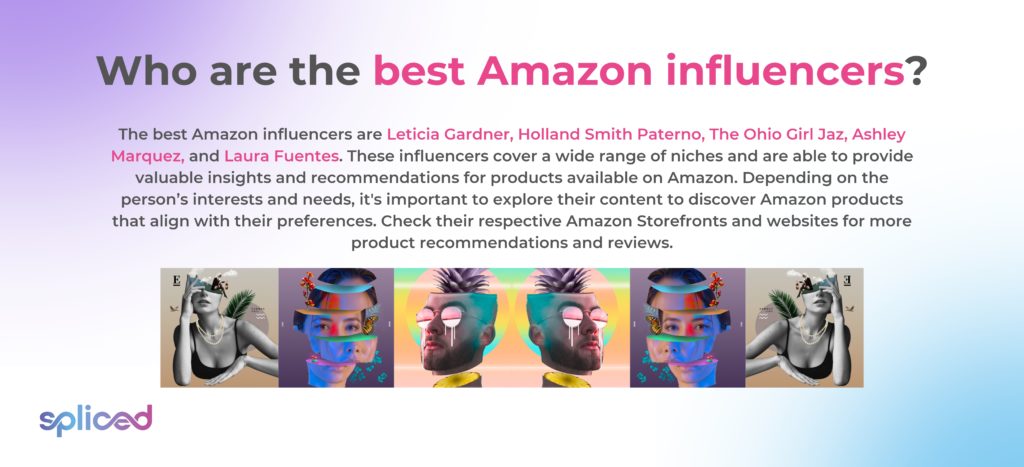
Who are the best Amazon influencers?
The best Amazon influencers are Leticia Gardner, Holland Smith Paterno, The Ohio Girl Jaz, Ashley Marquez, and Laura Fuentes. These influencers cover a wide range of niches and are able to provide valuable insights and recommendations for products available on Amazon. Depending on the person’s interests and needs, it’s important to explore their content to discover Amazon products that align with their preferences. Check their respective Amazon Storefronts and websites for more product recommendations and reviews.
Leticia Gardner has a massive following across TikTok, Instagram, and YouTube. Leticia specializes in fitness, lifestyle, fashion, and family-related content. Totalbody21 is Leticia’s brand that centers around fitness and wellness products. Leticia Gardner’s combination of a substantial following, niche relevance, and a strong brand presence in the fitness and wellness space makes Leticia a highly effective influencer for promoting products on Amazon, particularly those related to health, beauty, and fitness.
Holland Smith Paterno, as a fashion and lifestyle micro-influencer with followers on TikTok and Instagram, is highly effective in promoting products on Amazon, particularly those related to fashion, beauty, and home. Holland Smith Paterno’s niche focus, authentic style, and visually appealing content act as effective influencers for promoting Amazon products, especially in the fashion, beauty, and home categories. The relatability and engagement with the audience lead to higher conversion rates and successful Amazon product promotions.
The Ohio Girl Jaz, a micro-influencer specializing in fashion, travel, and beauty content, is highly effective in promoting products on Amazon, particularly through Jaz’s relaxed and affordable style and regular “Amazon hauls.” Authenticity and engagement with the audience contribute to higher conversion rates and the success of Amazon product promotions.
Ashley Marquez’s expertise in education, motivation, fashion, kids’ products, and lifestyle content equips Ashley to effectively promote a wide range of Amazon products. Ashley’s influence, combined with authenticity and engagement, drives conversions and contributes to the success of Amazon product campaigns within the niche and beyond.
Laura Fuentes is a powerful influencer who promotes a wide range of Amazon products, particularly those related to cooking, health, and wellness. Laura’s credibility in the area, combined with engaging content, drives conversions and contributes to the success of Amazon product campaigns both inside and outside the industry.
These best Amazon Influencers cater to various niches, making them valuable resources for discovering Amazon products that align with one’s interests and needs. Visit their websites and Amazon shops to read in-depth product reviews and recommendations.
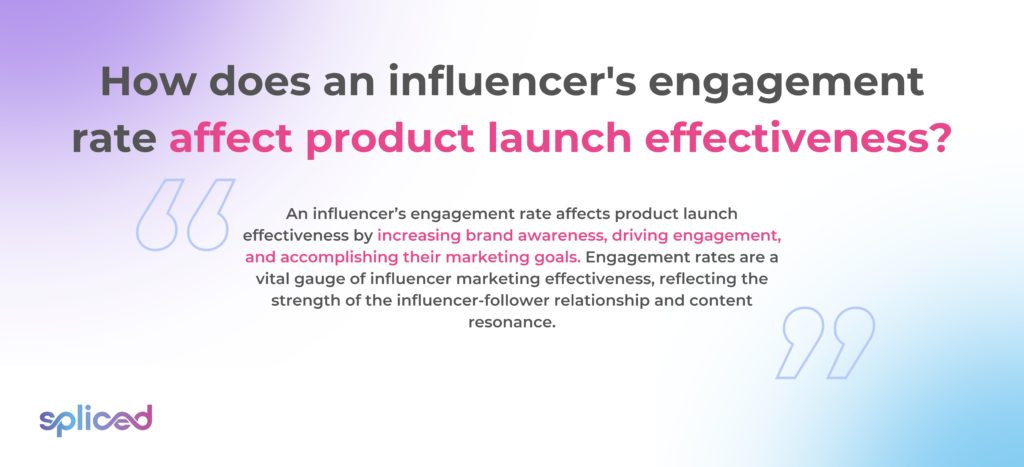
How does an influencer’s engagement rate affect product launch effectiveness?
An influencer’s engagement rate affects product launch effectiveness by increasing brand awareness, driving engagement, and accomplishing their marketing goals. Engagement rates are a vital gauge of influencer marketing effectiveness, reflecting the strength of the influencer-follower relationship and content resonance.
Engagement rates act as a barometer of an influencer’s relationship with their followers. The rates are indispensable because they measure the level of interaction between influencers and their followers, highlighting the authenticity and trustworthiness of the relationship. A high engagement rate signifies an audience that trusts the influencer and actively connects with their content.
Influencer marketing campaigns benefit greatly from the use of content that has a high rate of engagement because it is used to increase brand recognition, sales, and customer loyalty. The phenomenon happens as a result of social media algorithms favoring content that is highly engaged, which increases visibility and exposure.
Engagement rates are calculated by dividing the number of interactions, such as likes, comments, and shares, by the total of followers and multiplying by 100. The metric is calculated per-post or as an average across an influencer’s content, providing insights into their ability to resonate with their audience.
Engagement rates aren’t the sole metric of success, and brands must consider other essential metrics such as traffic and impressions when evaluating the effectiveness of influencer marketing campaigns. Reach pertains to the number of unique individuals who view the influencer’s content, while impressions reflect the total number of times the content has been viewed.
Several factors influence an influencer’s engagement rates, including content quality, relevance to the target audience, content type, and follower count. Excellent content is more inclined to engage followers, and content creators enhance quality through visuals, captions, and authenticity. The content must be relevant to the influencer’s audience and align with their interests, values, and preferences.
Influencers who create content aligned with their brand and audience are more likely to achieve higher engagement rates. Smaller influencers with dedicated followings outperform larger ones in terms of engagement rate because their followers feel a stronger connection to them.
Influencers increase engagement rates in influencer marketing by interacting with their audience, posting at optimal times, and teaming up with other influencers. Improved audience engagement, increased content significance, and wider dissemination are outcomes of the tactics that are applied to any influencer marketing campaign.
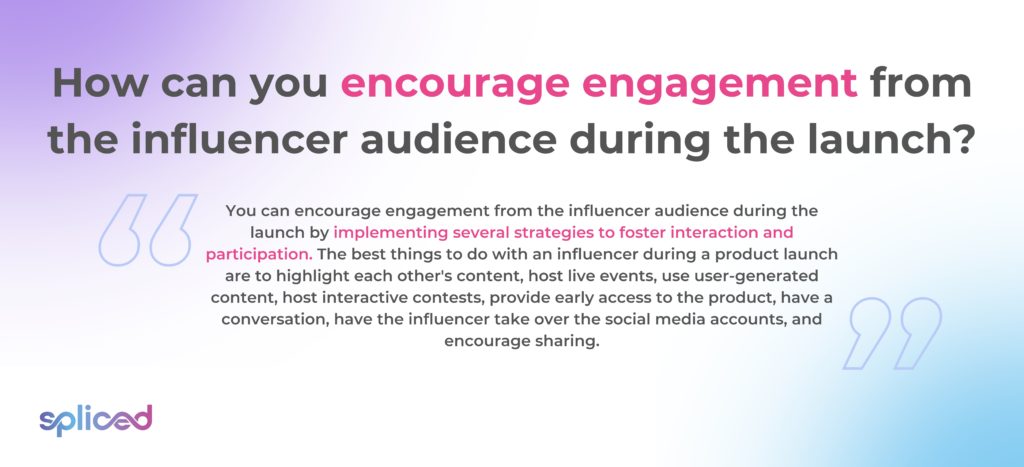
How can you encourage engagement from the influencer audience during the launch?
You can encourage engagement from the influencer audience during the launch by implementing several strategies to foster interaction and participation. The best things to do with an influencer during a product launch are to highlight each other’s content, host live events, use user-generated content, host interactive contests, provide early access to the product, have a conversation, have the influencer take over the social media accounts, and encourage sharing.
The content that influencers make about a product or event and share with their followers doesn’t reach as many people unless it is amplified. Repost, reshare, or reuse their content on the brand’s own social media accounts, website, blog, newsletter, or ads. It extends the content’s reach and shows appreciation for the influencer’s efforts in creating it.
Encourage influencers to cross-promote their content on different platforms. They’re able to cross-post to their other social media accounts if they have made something particularly interesting on Instagram. The multi-platform approach ensures that the message reaches a diverse audience, increasing the likelihood of engagement.
Invite the influencers to participate in live events, webinars, or podcasts related to the product launch. Their presence adds credibility and authority to the event, and they are able to interact with attendees directly, answering questions and providing insights. The real-time engagement sparks discussions and generates interest.
Encourage those who have benefited from the influencers’ recommendations to create and share user-generated content. Feature their feedback, photos, videos, or testimonials on the platforms. UGC provides social proof and allows the audience to see real-life experiences with the product or event, making it more relatable.
Actively engage with comments and questions on the influencer’s posts or the amplified contents. Respond promptly, address inquiries, and express gratitude for feedback. Demonstrating the commitment to customer interaction and fosters a sense of community.
Organize interactive contests or challenges related to the product launch where influencers and their followers participate. Encourage user-generated content submissions and offer prizes or incentives for the most creative or engaging entries. The gamified approach boosts engagement and encourages active involvement.
Provide influencers with exclusive access to the product or event before the official launch. They build up interest by giving their audience access to exclusive material such as behind-the-scenes footage or early reviews. The exclusivity generates excitement and engagement as followers eagerly await the launch.
Foster meaningful conversations around the product or event by asking thought-provoking questions, conducting polls, or initiating discussions related to the launch. Engage with participants by acknowledging their input and insights, creating a sense of involvement and community.
Allow influencers to take over the brand’s social media accounts for a day or specific event related to the launch. They share their perspectives, conduct live Q&A sessions, or provide exclusive content. The takeover approach introduces their followers to the brand and encourages interaction.
Prompt influencers and their followers to share content related to the launch and tag the brand or event hashtag. Offer incentives or recognition for the most impactful shares and tags. The user-driven promotion expands reach and drives engagement.
Incorporating the strategies into the influencer marketing campaign during a product launch fosters active engagement from the influencer’s audience, maximizes exposure, and creates a buzz around the offering, ultimately contributing to a successful launch.
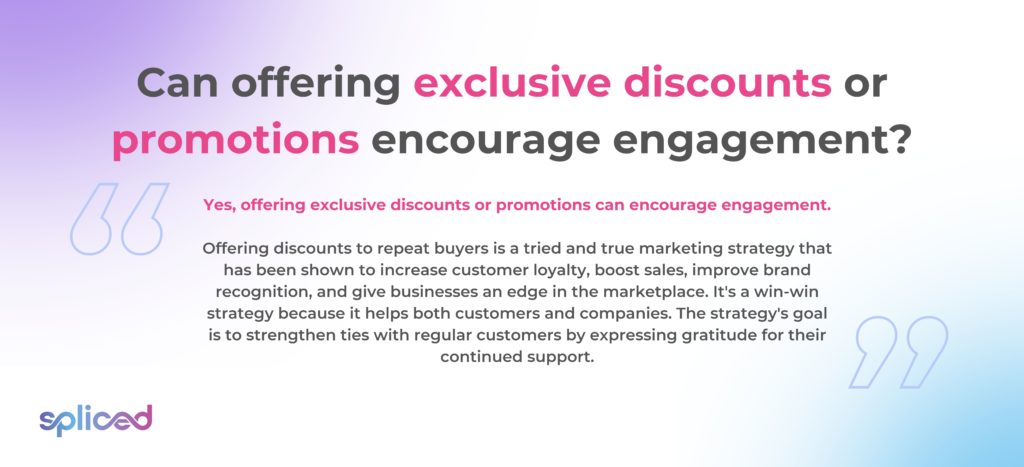
Can offering exclusive discounts or promotions encourage engagement?
Yes, offering exclusive discounts or promotions can encourage engagement. Offering discounts to repeat buyers is a tried and true marketing strategy that has been shown to increase customer loyalty, boost sales, improve brand recognition, and give businesses an edge in the marketplace. It’s a win-win strategy because it helps both customers and companies. The strategy’s goal is to strengthen ties with regular customers by expressing gratitude for their continued support. Businesses attract and keep customers by providing unique deals for a limited period of time. It makes customers feel valued and helps them stand out from the competition.
There is no way to overstate how crucial it is to give loyal customers special deals. Special deals signify that a brand values and acknowledges its dedicated customer base, ultimately strengthening the customer-brand relationship. The appreciation translates into increased customer loyalty and a higher likelihood of repeat purchases, driving sales growth. The feeling of uniqueness associated with the deals creates a sense of pressure, urging clients to make quicker purchasing decisions and potentially spend more money.
One of the primary benefits of providing exclusive deals to loyal customers is improved customer retention. Customers are less likely to switch brands when they feel appreciated and rewarded for their loyalty. The extra perks and benefits customers receive as a result of their loyalty are a major reason why they continue to be customers. Tailoring exclusive deals to meet the specific needs and interests of loyal customers goes a long way toward making them feel valued and recognized.
The potential of more sales is another major perk. Access to special offers tends to produce repeat buyers and brand advocates. The success of a business is increased through the use of word-of-mouth advertising. Customers’ perceptions of a company improve when they’re offered special discounts. Customers have a positive impression of firms that invest in loyalty programs and personalized discounts. The brand’s excellent reputation helps boost customer retention rates and even draws in new clients.
Providing exclusive deals and promotions gives a brand an edge over competitors. Brands that offer superior deals and promotions compared to their competitors attract and retain customers. The advantage drastically alters the outcome within a very competitive market, giving rise to greater market penetration and continued expansion.
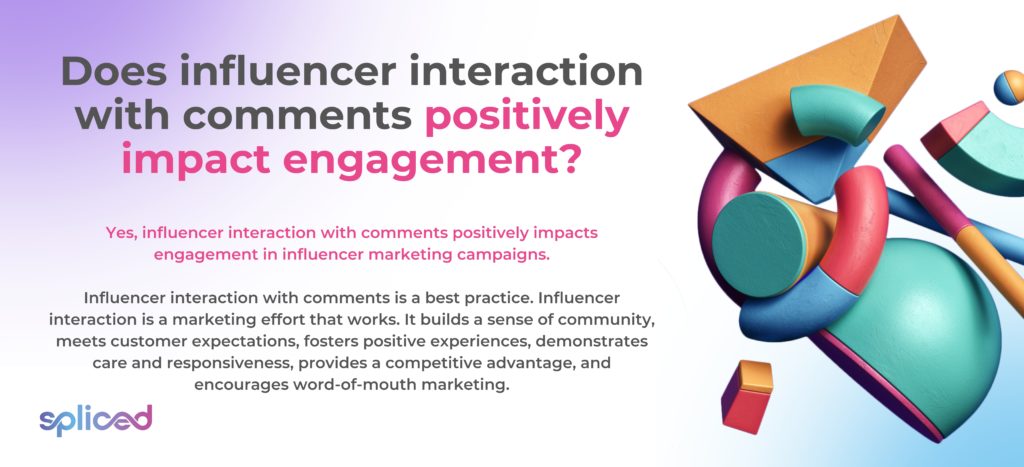
Does influencer interaction with comments positively impact engagement?
Yes, influencer interaction with comments positively impacts engagement in influencer marketing campaigns. Influencer interaction with comments is a best practice. Influencer interaction is a marketing effort that works. It builds a sense of community, meets customer expectations, fosters positive experiences, demonstrates care and responsiveness, provides a competitive advantage, and encourages word-of-mouth marketing. Each of these factors contributes to higher engagement levels and stronger brand relationships with the audience.
Active engagement with comments in influencer marketing serves as a cornerstone for building a vibrant online community. Influencers foster a sense of belonging among their followers by responding to their comments, thereby transforming them from passive observers to active participants in a larger conversation. Customers, especially millennials, in today’s digital era expect brands and social media influencers to be easily accessible and responsive, making the practice ideal. The interactions, even through simple gestures such as emojis or expressions of gratitude, create a welcoming and positive atmosphere, nurturing a loyal fan base. It sends a clear message of care and responsiveness, strengthening brand credibility. The interaction strategy makes brands and influencers stand out in a competitive market, giving them an edge and showing that they care about their customers. Happy followers are more likely to share the brand’s content and suggestions with their own networks, which boosts engagement and fuels word-of-mouth marketing.
